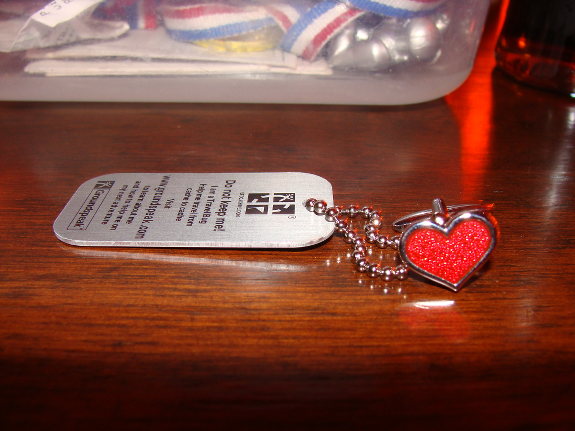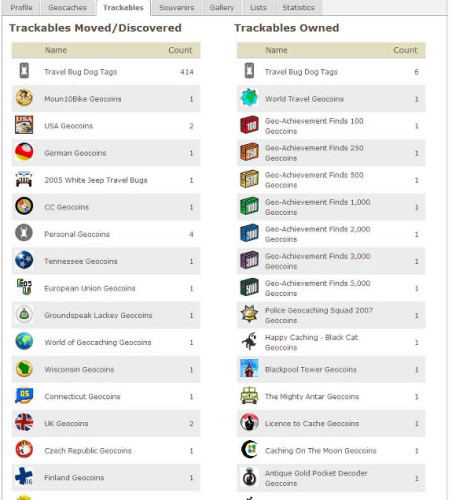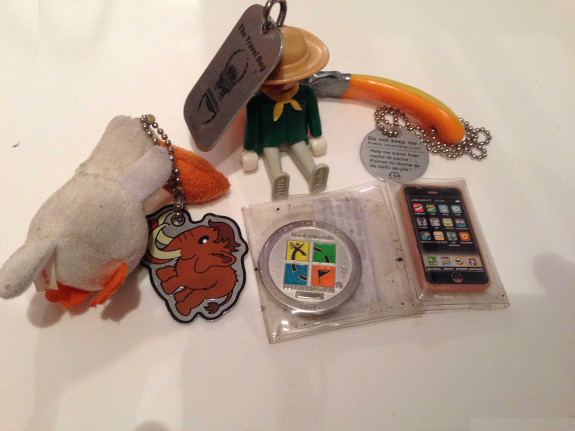
It’s likely that if you’ve ever been geocaching, you’ve heard people talk about trackables. But if you’ve ever wondered what exactly they are or how they form part of the game this article should give you the answers to all the basics and provide a few tips for moving trackables or setting off one of your own.
Two types of trackables
You will generally find that trackables fall into one of two categories: travel bugs (a dog tag sometimes plain, sometimes shaped and designed, that is usually attached to an item) and geocoins (a metal or wooden coin with some form of design on it). What they both have in common is a unique tracking code, printed or engraved into them. This code is then used on the Geocaching.com website by geocachers who find the item to virtually log it in and out of geocaches they place it in or retrieve it from. The result is a complete virtual history of where the trackable has travelled, who picked it up and where they dropped it off. Geocachers who log travel bugs and geocoins get their accomplishment recorded on a tab of their Geocaching.com user profile page. Many trackables have unique icons and it can be a challenge to see just how many of the thousands available you can amass.

Trackables logged on geocaching.com
There’s a mission to this madness
Most trackables will have some sort of mission or goal. Maybe it’s to eventually reach a certain location or visit certain types of places (such as geocaches near farms). New geocachers often make the mistake of holding onto a trackable until they visit a geocache that exactly matches the trackable’s goals, or until they meet another geocacher who can take the trackable to its destination. In reality you should try and move it on as a soon as possible even if it’s to a geocache at odds to the ultimate goal. Better to keep it moving than to keep hold of it. Who knows, maybe the next geocacher who finds the trackable will be better able to help? As well as being retrieved and dropped off, trackables can be discovered or grabbed. At events, some geocachers will allow you to look at their collection of geocoins that have not been released into the wild. Some geocoins are so ornate that owners feel there’s sadly a high chance of them getting stolen. If you make a note of the tracking code and, when you come to log the trackable on the Geocaching.com website, select ‘discover’ you will get credit for finding the geocoin but it will remain in the owner’s virtual (as well as physical) possession. In instances where you find the trackable in a different geocache to what it is reporting online, there is the option to ‘grab it’. Keep in mind that the previous guardian of the trackable might take a few days to log their finds, so if you find a travel bug or geocoin that says it’s currently in another geocacher’s possession, wait a week or so to allow them time to log it into the geocache. If after that time and a polite email, you’ve not had any response or update, go ahead and “grab it” but help the trackable owner by also “dipping it” into the geocache you found it by adding a note to the geocache page with the “visited” option selected for the trackable.
How long is too long?
There’s no universally acceptable time for how long it is before you’ve held onto a trackable for too long, but as a rule of thumb, aim to have moved it on within a month. Also because you are only moving the trackable rather than actually taking ownership of it, you do not need to swap it with something in your possession of equal or greater value like you do with most geocache contents. Another mistake a lot of new geocachers make is picking up a trackable from one geocache and then dropping it in the next, and only realising once they return home that they forgot to take a note of the tracking code so they could log the move on the website. A good practise is to never drop off a trackable the same day as you pick it up. Buy yourself a canvas pencil case and keep your incoming and outgoing trackables separate. It will save you a lot of hassle.
Placing your own trackable
If you are thinking of setting your own trackable out into the world, keep in mind that it will go missing at some point. That might be after travelling two miles down the road or after twice circumnavigating the globe. Sometimes they get lost when a geocache is muggled, sometimes a new geocacher tries out geocaching and then never returns to move on the trackables they’ve picked up, and sometimes they are stolen. However, it’s not uncommon for trackables long thought lost to suddenly reappear. For that reason it is usually best to only buy trackables from reputable online stores, such as the places you buy your geocaching supplies from. They will come to you unactivated, and before you put it out in the world, you need to follow the specific activation instructions to ensure the trackable is registered to you. This will allow you, amongst other things, to set the trackable’s goal and to be notified when it moves.

An assortment of trackables
Setting a goal
If you do set a goal for it, try and keep it general and encourage it to keep moving. Even if you attach a laminated goal to the trackable, most geocachers probably won’t take time to read it until they get back home and go to log their find. I’ve seen some trackable owners make the mistake of trying to limit where the trackable should travel (either to a state or country) and then get annoyed when another geocacher visits an area, picks up trackables to move on and takes them back home. The best trackables are the ones with a simple goal of to keep moving. You’ll find they seem to stick in one area for months or even years before someone comes along and suddenly they are half-way round the world. Trackables can be both fun to own as well as find and move on. So next time you find a large ammo container think about double checking to see if there are any trackables within; or possibly consider placing one of your own geocoins or travel bugs into a geocache to set it off on an adventure.

